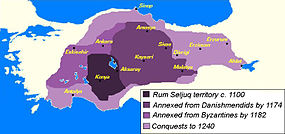ਰੂਮ ਸਲਤਨਤ
ਰੂਮ ਸਲਤਨਤ (Turkish: Anadolu Selçuklu Devleti[4], Persian: سلجوقیان روم) ਆਨਾਤੋਲੀਆ ਦਾ ਇੱਕ ਮੱਧਕਾਲੀ ਤੁਰਕ-ਫ਼ਾਰਸੀ[5] ਸੁੰਨੀ ਇਸਲਾਮ[6] ਰਾਜ ਸੀ। ਇਹ ਰਾਜ 1077 ਤੋਂ ਲੈਕੇ 1307 ਤੱਕ ਰਿਹਾ। ਇਸਦੀਆਂ ਰਾਜਧਾਨੀ ਪਹਿਲਾਂ ਈਜ਼ਨੀਕ ਸੀ ਅਤੇ ਬਾਅਦ ਵਿੱਚ ਕੋਨਿਆ ਸੀ।
ਰੂਮ ਸਲਤਨਤ Anadolu Selçuklu Devleti سلجوقیان روم | |||||||||||||||||||||||
|---|---|---|---|---|---|---|---|---|---|---|---|---|---|---|---|---|---|---|---|---|---|---|---|
| 1077–1307 | |||||||||||||||||||||||
 Roman Eagle was used as a symbol for the Sultanate of Rum (Roma) | |||||||||||||||||||||||
 1100 ਤੋਂ 1240 ਤੱਕ ਸਲਤਨਤ ਦਾ ਫੈਲਾਅ | |||||||||||||||||||||||
| ਸਥਿਤੀ | ਸਲਤਨਤ | ||||||||||||||||||||||
| ਰਾਜਧਾਨੀ | ਨੇਕਿਆ (ਈਜ਼ਨੀਕ) ਕੋਨਿਆ ਸਿਵਾਸ | ||||||||||||||||||||||
| ਆਮ ਭਾਸ਼ਾਵਾਂ | ਫ਼ਾਰਸੀ (ਦਫ਼ਤਰੀ ਅਤੇ ਸਾਹਿਤਕ)[1][2] ਪੁਰਾਣੀ ਆਨਾਤੋਲੀਆਈ ਤੁਰਕੀ[3] | ||||||||||||||||||||||
| ਸਲਤਾਨ | |||||||||||||||||||||||
• 1077–1086 | ਰੂਮ ਦਾ ਸੁਲੇਮਾਨ ਪਹਿਲਾ | ||||||||||||||||||||||
• 1303–1308 | ਮੇਸੂਦ II | ||||||||||||||||||||||
| ਇਤਿਹਾਸ | |||||||||||||||||||||||
• ਮਹਾਨ ਸਲਜੂਕ ਸਲਤਨਤ ਵਿੱਚੋਂ ਟੁੱਟ ਕੇ ਬਣਿਆ | 1077 | ||||||||||||||||||||||
• ਅੰਦਰੂਨੀ ਝਗੜੇ | 1307 | ||||||||||||||||||||||
| ਖੇਤਰ | |||||||||||||||||||||||
| 1243 | 400,000 km2 (150,000 sq mi) | ||||||||||||||||||||||
| |||||||||||||||||||||||
"ਰੂਮ" ਸ਼ਬਦ ਰੋਮਨ ਸਾਮਰਾਜ ਲਈ ਅਰਬੀ ਸ਼ਬਦ ਤੋਂ ਆਇਆ ਹੈ।[7]
ਸਥਾਪਨਾ
ਸੋਧੋ1070 ਵਿਆਂ ਵਿੱਚ ਮਲਾਜ਼ਗਰਦ ਦੀ ਜੰਗ ਤੋਂ ਬਾਅਦ ਸੁਲੇਮਾਨ ਇਬਨ ਕੁਤਲਮਿਸ਼, ਜੋ ਮਹਾਨ ਸਲਜੂਕ ਸਾਮਰਾਜ ਦੇ ਸੁਲਤਾਨ ਬਣਨ ਲਈ ਇੱਕ ਦਾਅਵੇਦਾਰ ਸੀ, ਨੇ ਪੱਛਮੀ ਆਨਾਤੋਲੀਆ ਵਿੱਚ ਆਪਣਾ ਅਲਗ ਰਾਜ ਸਥਾਪਿਤ ਕਰ ਲਿਆ। 1075 ਵਿੱਚ ਇਸਨੇ ਈਜ਼ਨੀਕ ਅਤੇ ਈਜ਼ਮੀਤ ਸ਼ਹਿਰਾਂ ਉੱਤੇ ਕਬਜ਼ਾ ਕੀਤਾ। ਇਸਤੋਂ ਦੋ ਸਾਲ ਬਾਅਦ ਉਸਨੇ ਆਪਣੇ ਆਪ ਨੂੰ ਇਸ ਸੁਤੰਤਰ ਸਲਜੂਕ ਰਾਜ ਦਾ ਸੁਲਤਾਨ ਘੋਸ਼ਿਤ ਕਰ ਦਿੱਤਾ ਅਤੇ ਇਸਦੀ ਰਾਜਧਾਨੀ ਈਜ਼ਨੀਕ ਵਿਖੇ ਸਥਾਪਿਤ ਕੀਤੀ।[8]
ਹਵਾਲੇ
ਸੋਧੋ- ↑ Grousset, Rene, The Empire of the Steppes: A History of Central Asia, (Rutgers University Press, 2002), 157; "...the Seljuk court at Konya adopted Persian as its official language.".
- ↑ Bernard Lewis, Istanbul and the Civilization of the Ottoman Empire, (University of Oklahoma Press, 1963), 29; "The literature of Seljuk Anatolia was almost entirely in Persian...".
- ↑ Encyclopedia Britannica: "Modern Turkish is the descendant of Ottoman Turkish and its predecessor, so-called Old Anatolian Turkish, which was introduced into Anatolia by the Seljuq Turks in the late 11th century ad." [1]
- ↑ "ਪੁਰਾਲੇਖ ਕੀਤੀ ਕਾਪੀ" (PDF). Archived from the original (PDF) on 2018-07-19. Retrieved 2016-01-17.
- ↑ Bernard Lewis, Istanbul and the Civilization of the Ottoman Empire, 29; "Even when the land of Rum became politically independent, it remained a colonial extension of Turco-Persian culture which had its centers in Iran and Central Asia","The literature of Seljuk Anatolia was almost entirely in Persian...".
- ↑ "Institutionalisation of Science in the Medreses of pre-Ottoman and Ottoman Turkey", Ekmeleddin Ihsanoglu, Turkish Studies in the History and Philosophy of Science, ed. Gürol Irzik, Güven Güzeldere, (Springer, 2005), 266.
- ↑ Christianity in Persia and the Status of Non-muslims in Iran By A. Christian Van Gorder, P.215
- ↑ Sicker, Martin, The Islamic world in ascendancy: from the Arab conquests to the siege of Vienna , (Greenwood Publishing Group, 2000), 63-64.